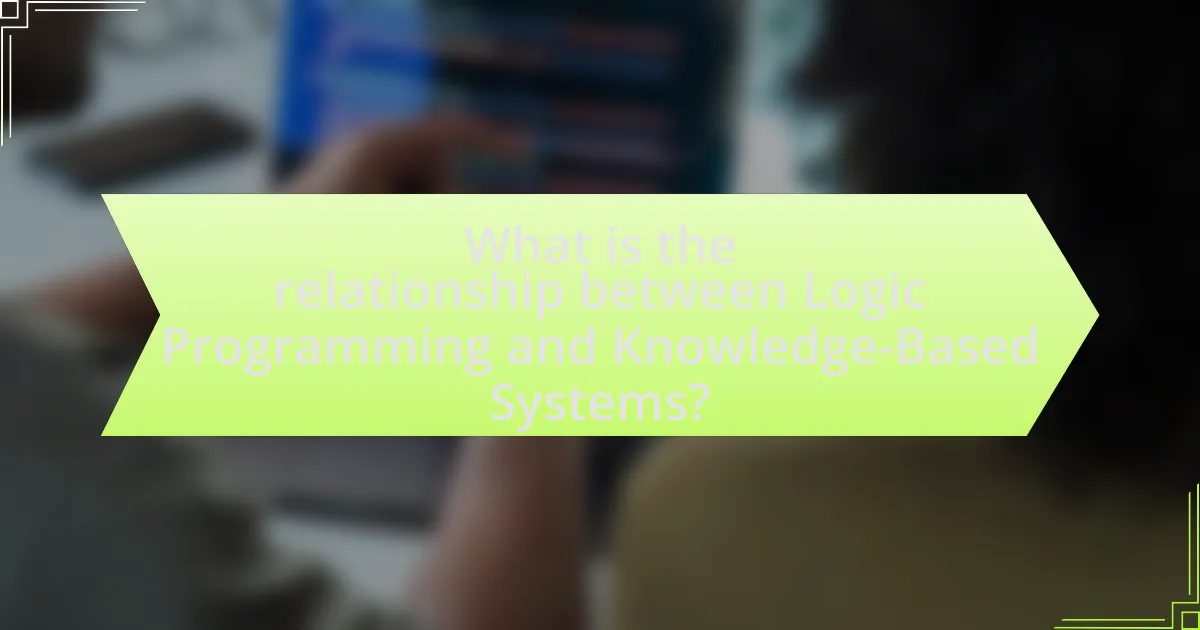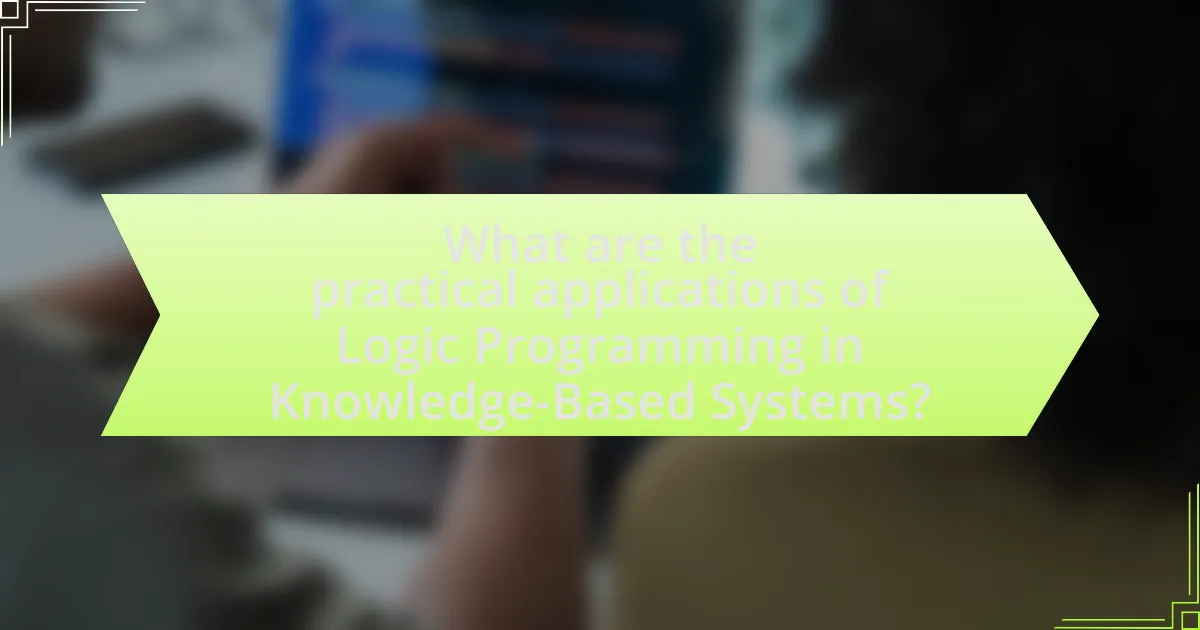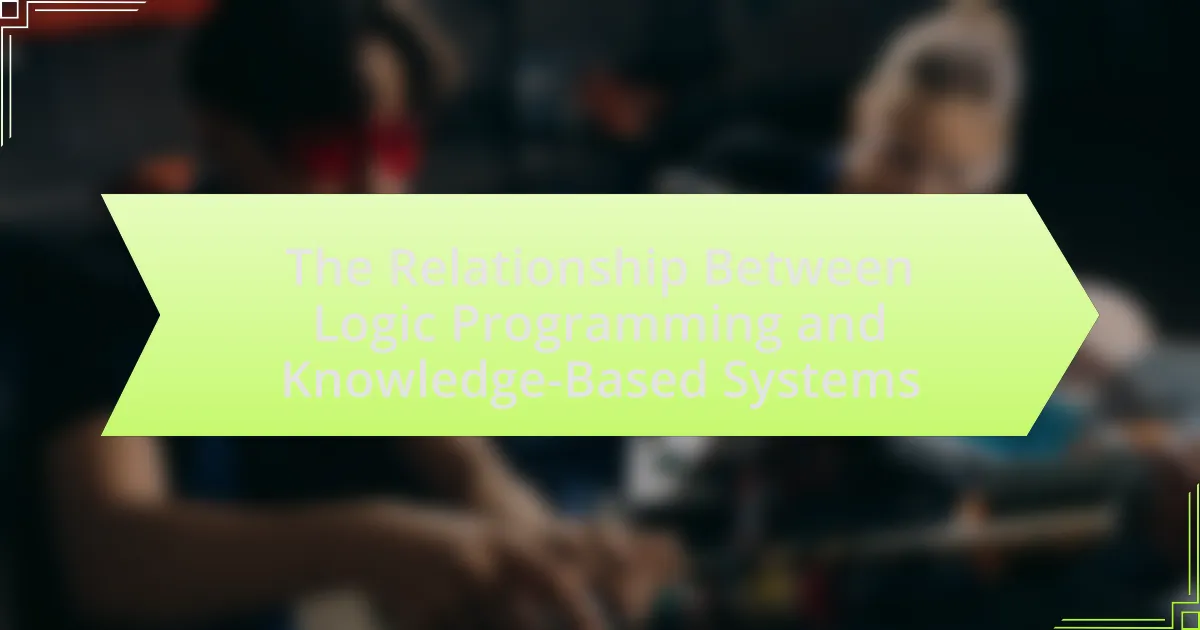Logic Programming serves as a foundational framework for Knowledge-Based Systems, enabling effective knowledge representation and reasoning. The article explores the interaction between these two domains, highlighting how Logic Programming languages like Prolog facilitate automated reasoning through structured facts and rules. Key components such as predicates, rules, and inference mechanisms are discussed, along with the advantages and challenges of integrating Logic Programming into Knowledge-Based Systems. Practical applications in artificial intelligence, natural language processing, and decision support systems are also examined, emphasizing the importance of best practices for successful implementation.

What is the relationship between Logic Programming and Knowledge-Based Systems?
Logic Programming serves as a foundational framework for Knowledge-Based Systems, enabling them to represent and reason about knowledge effectively. Knowledge-Based Systems utilize Logic Programming languages, such as Prolog, to encode rules and facts, facilitating automated reasoning and inference. This relationship is evidenced by the fact that many Knowledge-Based Systems are built on Logic Programming principles, allowing for the manipulation of symbolic information and the execution of logical queries.
How do Logic Programming and Knowledge-Based Systems interact?
Logic programming and knowledge-based systems interact through the use of formal logic to represent and manipulate knowledge. Logic programming provides a framework for defining rules and relationships, which knowledge-based systems utilize to infer new information and make decisions. For instance, Prolog, a prominent logic programming language, allows knowledge-based systems to encode facts and rules, enabling automated reasoning processes. This interaction enhances the capability of knowledge-based systems to solve complex problems by leveraging logical inference mechanisms, as evidenced by applications in expert systems and artificial intelligence.
What are the foundational principles of Logic Programming?
The foundational principles of Logic Programming include the use of formal logic as a programming paradigm, where programs are expressed in terms of relations and rules. Logic Programming relies on a declarative approach, allowing the programmer to specify what the program should accomplish without detailing how to achieve it. This paradigm is built on the concepts of facts, rules, and queries, enabling automated reasoning and inference.
The validity of these principles is supported by the historical development of Logic Programming languages, such as Prolog, which emerged in the early 1970s. Prolog’s design is rooted in first-order predicate logic, demonstrating how logical statements can be used to represent knowledge and solve problems through backtracking and unification. This framework allows for the creation of knowledge-based systems that can reason about information and derive conclusions based on given facts and rules.
How do Knowledge-Based Systems utilize Logic Programming?
Knowledge-Based Systems utilize Logic Programming by employing formal logic to represent knowledge and infer new information. Logic Programming allows these systems to define rules and facts in a structured manner, enabling automated reasoning and problem-solving capabilities. For instance, Prolog, a prominent Logic Programming language, facilitates the creation of knowledge bases where relationships and rules can be expressed, allowing the system to derive conclusions based on the provided data. This structured approach enhances the system’s ability to handle complex queries and make logical deductions, thereby improving decision-making processes in various applications such as expert systems and automated reasoning tasks.
What are the key components of Logic Programming?
The key components of Logic Programming are facts, rules, and queries. Facts represent basic assertions about the world, rules define relationships and infer new information from existing facts, and queries are used to retrieve information based on the defined facts and rules. These components work together to enable reasoning and problem-solving in a structured manner, as seen in systems like Prolog, which utilizes these elements to derive conclusions from a set of logical statements.
What role do predicates play in Logic Programming?
Predicates serve as fundamental building blocks in Logic Programming, representing relationships or properties of objects within a logical framework. In this context, predicates allow for the formulation of facts and rules that define the behavior of a program, enabling reasoning and inference. For instance, in Prolog, a popular Logic Programming language, predicates are used to express knowledge in the form of statements like “parent(john, mary),” which asserts that John is a parent of Mary. This structure facilitates the execution of queries and the derivation of conclusions based on the defined relationships, demonstrating the essential role predicates play in enabling logical reasoning and knowledge representation in Logic Programming.
How do rules and facts contribute to Logic Programming?
Rules and facts are fundamental components of Logic Programming, as they define the relationships and knowledge that the program can utilize to derive conclusions. In Logic Programming, facts represent basic assertions about the world, while rules specify how these facts can be combined or manipulated to infer new information. For example, in Prolog, a fact might state “Socrates is a man,” and a rule could express “All men are mortal.” This allows the system to conclude that “Socrates is mortal” based on the provided facts and rules. The effectiveness of Logic Programming relies on this structured approach, enabling automated reasoning and problem-solving through logical inference.
What are the main features of Knowledge-Based Systems?
Knowledge-Based Systems (KBS) primarily feature a knowledge base, inference engine, and user interface. The knowledge base stores domain-specific knowledge in a structured format, allowing the system to retrieve and utilize this information effectively. The inference engine applies logical rules to the knowledge base to derive new information or make decisions, demonstrating the system’s reasoning capabilities. The user interface facilitates interaction between the user and the KBS, enabling users to input queries and receive responses. These features collectively enhance the system’s ability to solve complex problems and provide intelligent solutions, as evidenced by their application in fields such as medical diagnosis and expert systems.
How do Knowledge-Based Systems represent knowledge?
Knowledge-Based Systems represent knowledge primarily through structured formats such as rules, frames, and ontologies. These systems utilize production rules, which are conditional statements that define actions based on specific conditions, allowing for logical reasoning and inference. For instance, a rule might state, “If it is raining, then carry an umbrella,” enabling the system to make decisions based on the current state of knowledge. Additionally, frames provide a way to organize knowledge into objects with attributes and values, facilitating the representation of complex information. Ontologies further enhance this by defining a set of concepts and categories in a domain, along with the relationships between them, which supports semantic understanding and interoperability among systems. This structured representation allows Knowledge-Based Systems to effectively process, retrieve, and utilize knowledge for problem-solving and decision-making tasks.
What inference mechanisms are used in Knowledge-Based Systems?
Knowledge-Based Systems utilize several inference mechanisms, primarily including forward chaining, backward chaining, and rule-based reasoning. Forward chaining is a data-driven approach that starts with known facts and applies inference rules to derive new facts until a goal is reached. Backward chaining, on the other hand, is a goal-driven method that begins with a goal and works backward to determine which facts must be true to support that goal. Rule-based reasoning employs a set of conditional statements (if-then rules) to draw conclusions from the knowledge base. These mechanisms are foundational in enabling Knowledge-Based Systems to process information and make decisions based on logical reasoning.

How do Logic Programming and Knowledge-Based Systems enhance problem-solving?
Logic Programming and Knowledge-Based Systems enhance problem-solving by providing structured frameworks for reasoning and decision-making. Logic Programming utilizes formal logic to express facts and rules, enabling automated inference and deduction, which allows systems to derive conclusions from known information efficiently. Knowledge-Based Systems leverage this capability by integrating vast amounts of domain-specific knowledge, facilitating complex problem-solving tasks such as diagnosis, planning, and natural language understanding. For instance, systems like Prolog exemplify how logic programming can solve problems through backtracking and unification, while expert systems apply knowledge representation techniques to emulate human expertise in specific fields, demonstrating their effectiveness in real-world applications.
What advantages do Logic Programming techniques offer to Knowledge-Based Systems?
Logic Programming techniques offer several advantages to Knowledge-Based Systems, primarily through their ability to represent knowledge in a formal, declarative manner. This representation allows for clear and unambiguous definitions of facts and rules, facilitating easier reasoning and inference processes. Additionally, Logic Programming supports automated theorem proving, enabling Knowledge-Based Systems to derive conclusions from existing knowledge without manual intervention.
Moreover, the use of backtracking in Logic Programming allows for efficient exploration of possible solutions, which is particularly beneficial in complex problem-solving scenarios. The expressiveness of Logic Programming languages, such as Prolog, enables the modeling of intricate relationships and constraints, enhancing the system’s capability to handle diverse knowledge domains. These advantages collectively contribute to the robustness and flexibility of Knowledge-Based Systems, making them more effective in various applications.
How does the use of Logic Programming improve reasoning capabilities?
The use of Logic Programming enhances reasoning capabilities by providing a formal framework for representing knowledge and deriving conclusions through inference. This programming paradigm allows for the expression of facts and rules in a declarative manner, enabling automated reasoning systems to deduce new information from existing knowledge. For instance, Prolog, a well-known Logic Programming language, utilizes a resolution-based inference mechanism that systematically applies logical rules to derive conclusions, thereby improving the efficiency and accuracy of reasoning processes in knowledge-based systems.
What impact does Logic Programming have on knowledge representation?
Logic Programming significantly enhances knowledge representation by providing a formal framework for expressing complex relationships and rules. This framework allows for the representation of facts and rules in a way that is both human-readable and machine-processable, facilitating automated reasoning. For instance, Prolog, a prominent logic programming language, enables the encoding of knowledge through predicates and logical clauses, which can be queried to infer new information. The effectiveness of Logic Programming in knowledge representation is evidenced by its application in various domains, such as artificial intelligence and natural language processing, where it supports the development of expert systems that can reason and make decisions based on represented knowledge.
What challenges arise in integrating Logic Programming with Knowledge-Based Systems?
Integrating Logic Programming with Knowledge-Based Systems presents several challenges, primarily due to differences in representation and reasoning mechanisms. Logic Programming relies on formal logic for knowledge representation, while Knowledge-Based Systems often utilize more flexible, heuristic-based approaches. This disparity can lead to difficulties in ensuring compatibility between the two systems, particularly in terms of knowledge acquisition and inference processes.
Moreover, the computational complexity associated with reasoning in Logic Programming can hinder the performance of Knowledge-Based Systems, especially when dealing with large datasets or real-time applications. For instance, the need for complete logical consistency in Logic Programming may conflict with the approximate reasoning often employed in Knowledge-Based Systems, complicating the integration process.
These challenges highlight the necessity for developing hybrid models that can effectively combine the strengths of both Logic Programming and Knowledge-Based Systems while addressing their inherent limitations.
What are the limitations of Logic Programming in complex systems?
Logic programming has several limitations in complex systems, primarily due to its inherent characteristics. One significant limitation is its inefficiency in handling large-scale problems, as logic programming relies on backtracking and can suffer from combinatorial explosion when searching for solutions. Additionally, logic programming often struggles with representing and reasoning about uncertainty, which is crucial in complex systems where not all information is known or deterministic. Furthermore, the declarative nature of logic programming can lead to difficulties in expressing certain types of algorithms, particularly those requiring state changes or procedural control. These limitations are evident in practical applications, such as in artificial intelligence, where systems often require more flexible and efficient approaches to manage complexity and uncertainty effectively.
How can these challenges be addressed in practical applications?
Challenges in the relationship between logic programming and knowledge-based systems can be addressed through the integration of hybrid approaches that combine the strengths of both paradigms. For instance, utilizing logic programming for reasoning and knowledge representation while employing knowledge-based systems for data management and user interaction enhances overall system performance. Research indicates that systems like Prolog can be effectively integrated with knowledge-based frameworks to improve inference capabilities, as demonstrated in the work by Kowalski (2016) on the synergy between logic programming and artificial intelligence. This integration allows for more robust decision-making processes and better handling of uncertainty, thereby addressing practical application challenges.

What are the practical applications of Logic Programming in Knowledge-Based Systems?
Logic programming is practically applied in knowledge-based systems for tasks such as automated reasoning, natural language processing, and expert systems. Automated reasoning utilizes logic programming to derive conclusions from a set of premises, enabling systems to solve complex problems efficiently. In natural language processing, logic programming helps in understanding and generating human language by representing linguistic knowledge in a formal structure. Expert systems leverage logic programming to encode domain-specific knowledge, allowing them to provide solutions and recommendations based on logical inference. These applications demonstrate the effectiveness of logic programming in enhancing the functionality and intelligence of knowledge-based systems.
In which domains are Logic Programming and Knowledge-Based Systems commonly applied?
Logic Programming and Knowledge-Based Systems are commonly applied in domains such as artificial intelligence, natural language processing, expert systems, and database management. In artificial intelligence, they facilitate reasoning and problem-solving through formal logic. In natural language processing, they enable the understanding and generation of human language by modeling linguistic structures. Expert systems utilize these paradigms to emulate human decision-making in specialized fields like medicine and finance. Additionally, in database management, they support complex queries and data retrieval through logical inference mechanisms.
How is Logic Programming used in artificial intelligence applications?
Logic programming is utilized in artificial intelligence applications primarily for knowledge representation and reasoning. This paradigm allows for the formalization of facts and rules in a way that machines can process, enabling systems to infer new information from existing knowledge. For instance, Prolog, a well-known logic programming language, is widely used in expert systems, natural language processing, and automated theorem proving, demonstrating its effectiveness in handling complex queries and deriving conclusions based on logical relationships. The use of logic programming in AI facilitates the development of systems that can reason about data, making it a foundational element in knowledge-based systems.
What role do Knowledge-Based Systems play in decision support systems?
Knowledge-Based Systems (KBS) serve a critical role in decision support systems (DSS) by providing expert knowledge and reasoning capabilities that enhance decision-making processes. KBS integrate domain-specific knowledge with inference mechanisms, allowing DSS to analyze complex data and generate actionable insights. For instance, in medical diagnosis, KBS can evaluate patient symptoms against a vast database of medical knowledge, leading to more accurate diagnoses and treatment recommendations. This capability is supported by the fact that KBS can utilize logic programming to formalize knowledge representation, enabling systematic reasoning and problem-solving within DSS frameworks.
What best practices should be followed when implementing Logic Programming in Knowledge-Based Systems?
When implementing Logic Programming in Knowledge-Based Systems, best practices include ensuring clarity in the representation of knowledge, optimizing the efficiency of inference mechanisms, and maintaining modularity in code design. Clarity in knowledge representation allows for easier understanding and manipulation of facts and rules, which is essential for effective reasoning. Optimizing inference mechanisms, such as using efficient algorithms for query processing, enhances system performance and responsiveness. Maintaining modularity in code design facilitates easier updates and maintenance, allowing for the integration of new knowledge without disrupting existing functionalities. These practices are supported by the need for robust and scalable systems, as evidenced by successful implementations in various applications, including expert systems and automated reasoning tools.
How can developers ensure effective integration of Logic Programming techniques?
Developers can ensure effective integration of Logic Programming techniques by adopting a structured approach that emphasizes clear problem representation and the use of established frameworks. This involves utilizing formal logic to define knowledge bases, which allows for efficient querying and reasoning. For instance, Prolog, a prominent Logic Programming language, facilitates the representation of facts and rules, enabling developers to create systems that can infer new information from existing data. Empirical studies, such as those conducted by Kowalski in “Logic for Problem Solving,” demonstrate that structured logic can significantly enhance the performance of knowledge-based systems by improving their ability to handle complex queries and reasoning tasks.
What common pitfalls should be avoided in this integration process?
Common pitfalls to avoid in the integration process of logic programming and knowledge-based systems include inadequate requirement analysis, lack of clear communication among stakeholders, and insufficient testing. Inadequate requirement analysis can lead to misunderstandings about system capabilities, resulting in a mismatch between user expectations and system functionality. Lack of clear communication among stakeholders often results in fragmented knowledge and inconsistent implementation strategies, which can hinder the integration process. Insufficient testing may lead to undetected errors and performance issues, ultimately compromising system reliability. These pitfalls are supported by industry reports indicating that 70% of integration projects fail due to poor planning and communication.



